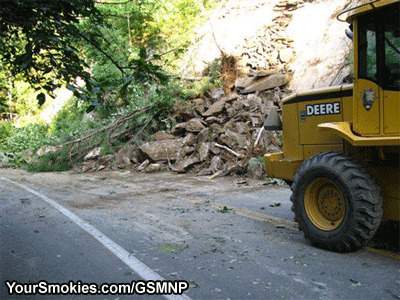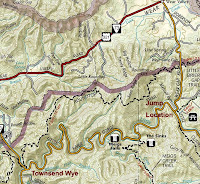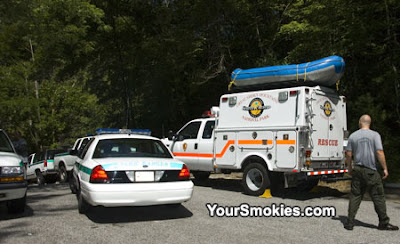Lost and then stranded experienced 70 year old hiker Albert Morgan Briggs who was stuck atop Porters Mountain for almost a week deep in the Great Smoky Mountains national park was rescued early this morning by a Tennessee Highway Patrol helicopter and taken to the Little River Ranger station where he was debriefed by park rangers about his ordeal and later picked up by his family and taken home.
What happened the past week to Albert Morgan Briggs who is a park volunteer and presently works in the parks backcountry permit office and prior to this was a ridge runner on the Appalachian Trail helping maintain the trails and guiding hikers, is both a tale of what hikers should and should not do.

Fortunately even though Morgan had what was a physically trying and well as emotionally draining week, other than a light sunburn and filthy clothes he was wearing from bushwhacking in the deep rhododendron thickets and climbing his way up about 1,200 feet to ridgeline below the Peak of Porters Mountain which is barely a few feet wide, he was in great shape and spirits.
When I was interviewing the crew of the helicopter that rescued Mr. Morgan, they all expressed concern about the conditions and the ruggedness of the backcountry he was stranded in. The crew also described that they could not believe how narrow the ridge was where Moran Briggs tent was precariously perched and how exposed he was.
If the helicopter could not have hoisted off the ridge on Porters Mountains, there would have been no room to put the bird down and the only way they would have had left to rescue him would have been for the ground crew to climb 1,200 feet practically straight up to retrieve him. The park service suggested that chainsaws would have probably been needed than in order to cut through the thickets.
Amazingly one of the teams of rangers on the search and rescue mission this week was less than 50 yards from Morgan Briggs and they did not realize the missing hiker was so close to them.
This distance was confirmed by checking the data of the ground crews GPS unit and according to North District Head Ranger Steven Kloster, the Porter Mountain ridgeline was already in today's search plan even if Morgan had not been spotted by observers on the Appalachian Trail (AT) and their sighting confirmed by a helicopter yesterday.
While I was able to gather information for this story from many firsthand sources, Morgan would not speak to any of us at the press conference but he did promise to give us the chance to interview him at a future date so at least we will have a more detailed picture of what initially happened and well as his state of mind during the week long ordeal.
I was in a rush to report all details of this story upon his rescue, but I held off as more and more questions and thoughts came to mind and more details have come to light about his ordeal. Many sources I have seen reporting this story had wrong information such as elevation gains and distances, made wrong conclusions and left out important facts.
Morgan's Planed 4 Day Hike in the GSMNP
Day 1: Hike from the Trailhead in Greenbrier where he was dropped off just 3.5 miles on the Porters Creek maintained hiking trail to backcountry campsite #31 where he would spend the night.
Day 2: Hike his way through brush on an unmaintained unofficial trail referred to as a "manway" where he would have to work his way through drainages making crossings in rain swollen creeks and streams, around fallen trees and through tough brush including rhododendron thickets and thorny briers that you would not normally encounter on a maintained official park trail.
Morgan would work his way up a gain of 2,000 feet and eventually end up along the Appalachian Trail which runs across most of the Great Smoky Mountains national parks highest points along the Tennessee North Carolina border for about a mile to a lean to along the AT named the Icewater Springs Shelter.
Day 3: Hike the 6 miles from the Icewater Springs Shelter along the AT and the Boulevard Hiking Trail to Mount LeConte where he would spend the night at the Mount LeConte Shelter.
Day 4: Hike down Mt LeConte to hitch a ride to Gatlinburg and take the trolley home to Pigeon Forge. No one other than Morgan is sure which trail he wished to take back but it is believed his choices were Alum Cave Trail (about 5 miles), Rainbow Falls (about 6.5 miles) or the Bull Head (about 6.5 miles) hiking trails.

What happened on the hike:
Day 1: Morgan hiked in and spent the first night as planned in campsite 31.
Day 2: He was last seen by other hikers this day at the campsite where after waking and packing his gear, he started the off trail portion of his hike he made a wrong turn and got disorientated and lost.
Rather than following the stream out to the road about 3 miles to the north he decided to climb up a little over 1,000 feet to the top of Porters Mountain where he pitched his tent and remained the next 6 days until he was rescued by helicopter.
So what went wrong and what went right in Morgan Briggs preparation, hike and subsequent rescue in the GSMNP?
What went right:
1) Though this story concluded with the safe return of a hiker who was lost and then stranded for a week with limited food and water and no way to communicate with the outside world, the timing of this hike more than likely made the difference between life and death.
If this fateful hike in the Great Smoky Mountains national park was a few weeks from now when the cold weather sets in, the risk of exposure would have been enormously increased - or if it was a few weeks earlier when it was very hot, humid and there was no rainfall Morgan could have suffered from severe dehydration or could have had a heat stroke and died.
The fact that he was so exposed on a high ridgeline, during any thunderstorm a bolt of lightning could have dealt him a lethal blow.
The weather also cooperated on the day of his rescue as the fog just lifted and visibility and wind speed just turned conducive for an extraction by chopper rather than a more prolonged and dangerous extraction by climbers.
2) Morgan Briggs told people where he was going and when he was due back. He filled out the necessary permits so he could be tracked.
Once he was overdue on Tuesday his family was concerned and eventually contacted the park service and the search for Albert Morgan Briggs began on Wednesday (Day 5).
3) When Morgan was lost on day 2 of the hike, he had worked his way to higher ground where he stayed put.
His highly visible yellow tent/tarp was seen by searches on the ground about a mile away on the AT because he was so visible and out of the cover of the forest canopy.
Had his tent/tarp been a color such as green or with camouflage pattern such as I often use, he may never have been spotted by the ground crew or the helicopter that eventually dropped him supplies.
4) When Morgan knew he was lost he started to ration his food which consisted of Spam and canned peaches.
Unfortunately both foods would increase his dehydration and subsequent thirst since the Spam is loaded with sodium and the peaches are in sugary syrup.
5) Though Morgan was working his way through mud and streams, where he ultimately ended up stranded there was no source of water so he ran dry.
Using tent flaps and a tarp he collected rain water from the daily rain we had last week in the Smokies.
While he was lost and stranded in the Great Smoky Mountains national park, dehydration was the largest danger he faced that could have proved fatal.
What went wrong:
1) Hiking on manways is not prohibited but is strongly advised against by GSM park officials.
Some manways such Pinnacles Manway in Greenbrier is in a similar condition to many maintained trails other than a few blow downs and is very clearly defined.
The manways that Morgan was hiking on are not clearly defined, in poor condition and have elevation gains that are unsafe given the condition of the trail.
This is not a manway that should ever be hiked solo and if you would do so, it is better to do it in the winter when the lack of most of the forest canopy makes following the trail and navigation with a GPS much easier.
This particular manway I have described numerous times as the only major manway in the Great Smoky Mountains national parks I have never hiked on because of the inherent dangers.
Hiking manways or off trail requiring bushwhacking does significant ecological damage to potentially endangered or rare plants, fragile habitats and their inhabitants.
Responsible off trail hiking should be done in the late fall, winter and early spring when the ground-cover and the understory is dormant so you are reducing your environment impact and it's also easier to read the terrain.
2) Morgan did not bring along any communications and navigation electronics.
A cell phone with Verizon service may have actually worked in his location, a GPS may have worked well enough to keep him from getting lost, a walkie talkie may have allowed him to communicate with another hiker in range on the AT and if all else fails he could have used a personal safety beacon as soon as he was stranded and he would have been rescued in hours rather than on day 8.
I tell everyone to never count on electronics for your survival when hiking and honesty hiking on marked and maintained trails you should not even need them, however when you hike solo on a dangerous unmarked trail it is ill advised to not have what is basic electronic safety equipment.
Any serious hiker going solo into a situation like this should never go hiking without a personal locator beacon.
|
|
3) A low tech visual signal method could have been used to call attention to him and his location: Fire and its subsequent smoke.
Though it is illegal to make a fire when in the national park outside of a fire ring or BBQ in a picnic area or campgrounds, in an emergency, fresh leaves burning would have brought attention to his position much faster.
Since he was camping and planning to be in shelters for days one would assume here would have brought along what it took to make a fire each night such as a lighter, matches or flint.
A camp fire with damp leaves would have made a smell and visual indicators of light and smoke which could have easily been seen or smelled by his rescuers.
Another low tech signaling device would be a mirror or anything reflective could have also been used to gain attention such as a used Spam can and lid or the can from his peaches.
4) Morgan did not have or use a signal whistle or air horn.
I swear by my trusty Storm Safety Whistle which can be heard for a half a mile or more in the conditions Morgan was in. It's a cheap low tech gadget that any hiker should have at all times - short hike or overnight trip.
A Storm Safety Whistle is louder than any other whistle and it even works underwater. Best investment under $10 you can make in saving your life and maybe even chasing an aggressive bear away.
Spend less than $12 and get a decent whistle, a signal mirror and a float, all of which take up almost no room in your pack (or pocket).
Air horns that use compressed gas come in small canister and are cheap and can also be heard for great distances. When the canister runs out of compressed gas you can put the horn in your mouth and blow.
Using a whistle or horn takes no energy as yelling does. Blowing a horn, whistle or shining a light in a "Short-Short-Short Long-Long-Long Short-Short-Short" SOS pattern is a universal cry for help in Morse Code.
Remember - searchers were as close as 50 yards away from him and he did not know they were there and they did not know he was there! Even a cheap whistle from Wal-Mart could have been heard at that distance.
Fortunately one of the search and rescue teams along the AT saw Morgan's yellow tent and were able to guide a helicopter to his location.
The helicopter returned with an extra sleeping bag, Gatorade, food and a park service radio so they were able to finally communicate with Mr. Briggs and prepare him for the rescue planed for the next day.
I would love to know that last night what Morgan was thinking that last night in his tent and when he finally woke up the next morning. We do know that pork chops were on his mind at some point because after leaving the national park with his brother along with his son and his family he wanted to stop by the supermarket for some to make for his first meal safe and sound back home.

This picture shows Morgan with his younger brother leaving the Little River ranger station along with all his hiking and camping gear which was also extracted from the top of Porter Mountain. Morgan looked well as he spoke quickly to park officials on the way to car.
His years of service were brought up by park officials including Park Superintendent Dale Ditmanson and how important the 2,000 plus park volunteers are to the Great Smoky Mountains national park. Morgan Briggs has helped countless other visitors to the park over the many years he has served the park and it was his turn to be helped.
Besides volunteers, there were 40 people who worked from the Great Smoky Mountains national park in the search and rescue teams. This did not include the 2 helicopter crews in 3 flights that were used to first find, then supply and finally to rescue Albert Morgan Briggs.
This was a well coordinated and expensive undertaking on the part of the national park service. Fortunately for the NPS and not the Tennessee tax payers, the cost of the helicopter retrieval off the mountain by a helicopter owned and flown by the Tennessee Highway Department, was paid for by the State of Tennessee.
As with any incident - especially one of this magnitude, there are lessons to be earned. While I travel with high visibility orange covers for my backpacks and 3 foil thermal blankets which would make a great signaling device, I am replacing my tent to one with a much higher visibility color based upon this incident.
While you need to careful anytime you hike in the wilderness, regardless of your hiking experience, my hope is that some of you will learn as I have and minimize the chance you can get lost and stranded in the Great Smoky Mountains and if you do survive until your swift rescue.
Related Stories:
- Rescue of a Lost and Stranded Hiker in the Great Smoky Mountains National Park Concludes
- Missing Hiker in Great Smoky Mountains National Park Alive but Not Out of the Woods - Yet
- Missing Hiker in Great Smoky Mountains National Park has been Found
- Search underway in the Great Smoky Mountains National Park for missing hiker Albert Morgan Briggs
- Search for Missing Hiker in the Great Smoky Mountains National Park is Still Unsuccessful






